Create function PatternStringLoop from SQL Server Central in your database.
I am pasting the same here for easy access.
-- PatternSplitLoop will split a string based on a pattern of the form
-- supported by LIKE and PATINDEX
--
-- Created by: Dwain Camps 11-Oct-2012
CREATE FUNCTION [dbo].[PatternSplitLoop]
( @String VARCHAR(400)
,@Pattern VARCHAR(500)
) RETURNS
@Results TABLE ( ItemNumber INT
,Item VARCHAR(400)
,[Matched] INT )
WITH SCHEMABINDING
AS
BEGIN;
-- DECLARE a couple of variables we'll need in our loop
DECLARE
@ItemNumber INT = 0
, @Remaining VARCHAR(400) = ISNULL(@String, '')
-- Create the "not pattern"
, @NotPattern VARCHAR(500) = REPLACE(REPLACE(@Pattern, '[', '[^'), '^^', '')
, @Matched INT
IF @String IS NULL OR @Pattern IS NULL
INSERT INTO @Results SELECT NULL, NULL, NULL
WHILE DATALENGTH(@Remaining) > 0
BEGIN
SELECT @ItemNumber = @ItemNumber + 1
-- The item returned from the cascaded CROSS APPLY b below
,@String = CASE
-- When a+b = 1, then either a=1 and b=0
--(the pattern was found but not pattern
-- was not found) or a=0 and b=1
-- (the not pattern was found but pattern was
-- not found).
-- This means that no meaninful patterns
--are found in what remains so we’re done.
WHEN a+b = 1 THEN @Remaining
-- This case returns the chunk up to the
-- start of the next pattern/not pattern
WHEN (a=1 AND b>0) OR (b=1 AND a>0)
THEN SUBSTRING(@Remaining, 1, CASE a
WHEN 1 THEN b
ELSE a
END - 1)
ELSE @Remaining
END
,@Matched=CASE a WHEN 1 THEN 1 ELSE 0 END
FROM (
-- Find the next occurrence of the Pattern and the NotPattern
SELECT PATINDEX(@Pattern, @Remaining)
, PATINDEX(@NotPattern, @Remaining)
) a(a, b)
-- Now that we have our ItemNumber and Item (in @String)
-- INSERT them into our results
INSERT INTO @Results SELECT @ItemNumber, @String, @Matched
-- Find the remaining characters in the string
SELECT @Remaining = CASE
WHEN DATALENGTH(@Remaining) = DATALENGTH(@String) THEN ''
ELSE SUBSTRING(@Remaining, DATALENGTH(@String)+1,
DATALENGTH(@Remaining))
END
END
RETURN
END
Next step, use CROSS APPLY over every VALUE field in Your database, and INSERT the result in a table variable.
The pattern %[a-zA-Z ]% looks for complete text only string in the field with a space.
DECLARE @data TABLE
(
ItemNumber INT,
Value VARCHAR(500),
Formatted VARCHAR(100),
Combined VARCHAR(500)
)
INSERT INTO @data
SELECT ItemNumber, Input, CASE WHEN Matched = 1
AND LTRIM(RTRIM(Item)) != '' THEN '[' + LTRIM(RTRIM(Item)) + ']'
ELSE Item END as Arranged, ''
FROM [YOUR_TABLE]
CROSS APPLY PatternSplitLoop(Input, '%[a-zA-Z ]%')
Once you have this, you can get distinct values in input in a temporary table variable with a IDENTITY column, since we need to combine the results for distinct input values.
DECLARE @tmp TABLE(
ID INT IDENTITY(1,1),
DistinctValue VARCHAR(500)
)
INSERT INTO @tmp(DistinctValue)
SELECT Distinct Value FROM @data
Loop through the temporary table variable with distinct values, and update the @data table variable with the resultant value.
DECLARE @minID INT = 1
DECLARE @maxID INT = 0
SELECT @maxID = COUNT(ID) FROM @tmp
DECLARE @currValue VARCHAR(500) = ''
WHILE (@minID <= @maxID)
BEGIN
SELECT @currValue = DistinctValue FROM @tmp WHERE ID = @minID
Update @data Set Combined = substring(
(
Select ' '+Formatted AS [text()]
From @data a WHERE Value = @currValue
ORDER BY a.ItemNumber
For XML PATH ('')
), 2, 1000) FROM @data a INNER JOIN @tmp b
ON a.Value = b.DistinctValue AND a.Value = @currValue
WHERE ItemNumber = 1
SET @minID = @minID + 1
SET @currValue = ''
END
Select the resulting output
SELECT Value AS Input, REPLACE(Combined, ' ', ' ') As Result
FROM @data WHERE ItemNumber = 1

